Effect of Ultrasonic Shot Peening on Microstructure and Corrosion Properties of GTA-Welded 304L Stainless Steel
Abstract
:1. Introduction
2. Experimental Methods
2.1. Specimen
2.2. Ultrasonic Shot Peening (USP) Treatment
2.3. Microscopic Observations
2.4. Hardness Measurement
2.5. Corrosion Tests
2.6. Residual Stress Measurement
3. Results and Discussion
3.1. Effect of USP on the Microstructure and Corrosion of the Surface of 304L Stainless Steel
3.2. Effect of USP on the Microstructure and Corrosion of the Cross-Section of 304L Stainless Steel
4. Conclusions
- (1)
- The surface was deformed and roughened due to ultrasonic shot peening. The welds (HAZ and weldment) were more deformed and rougher than the base material. The deformed areas of the surface formed crevices and the interior of the crevices contained some cracks. The crevices in the deformed areas reduced the pitting potential and decreased the resistance of the passive film by approximately 70%. Therefore, after the USP treatment, the surface had reduced corrosion properties.
- (2)
- After the USP treatment, the cross-section was subjected to grain refinement and deformation in the outermost areas. The weldment (HAZ and weldment) had approximately 30% deeper grain refinement zones and more deformation than the base metal, which further increased the hardness value. The outermost cross-sectional areas after peening increased the pitting potential and the resistance of the passive film from two to up to nine times because of the effect of compressive residual stress and grain refinement, which improved the corrosion properties. On the other hand, grain refinement increased the degree of sensitization due to the increase in the grain boundary areas.
Author Contributions
Funding
Data Availability Statement
Conflicts of Interest
References
- Larry, J. Welding and Metal Fabrication, 3rd ed.; Delmar Cengage Learning: New York, NY, USA, 2012; pp. 1–15. [Google Scholar]
- Farnsworth, S.R. Welding for Dummies, 3rd ed.; Wiley Publishing: New York, NY, USA, 2010; pp. 7–53. [Google Scholar]
- Lee, J.H.; Kim, K.T.; Pyoun, Y.S.; Kim, Y.S. Intergranular Corrosion Mechanism of Slightly Sensitized and UNSM-treated 316L Stainless Steel. Corros. Sci. Technol. 2016, 15, 226–236. [Google Scholar] [CrossRef]
- Lee, J.H.; Kim, Y.S. Intergranular Corrosion of 316L Stainless Steel by Aging and UNSM (Ultrasonic Nano-crystal Surface Modification) Treatment. Corros. Sci. Technol. 2015, 14, 313–324. [Google Scholar] [CrossRef]
- Tsai, W.T.; Chang, C.S.; Lee, J.T. Effects of Shot Peening on Corrosion and Stress Corrosion Cracking Behaviors of Sensitized Alloy 600 in Thiosulfate Solution. Corros. Sci. 1994, 50, 98–105. [Google Scholar] [CrossRef]
- Wang, T.; Yu, J.; Dong, B. Surface Nano Crystallization Induced by Shot Peening and its Effect on Corrosion Resistance of 1Cr18Ni9Ti Stainless Steel. Surf. Coat. Technol. 2006, 200, 4777–4781. [Google Scholar] [CrossRef]
- Kim, J.H.; Lee, W.R.; Kim, T.G.; Cheong, S.K. Micro-shockwave Measurement and Evaluation of Laser Shock Peening. Trans. Korean Soc. Mech. Eng. B 2011, 35, 1041–1046. [Google Scholar] [CrossRef]
- Lu, J.Z.; Qi, H.; Luo, K.Y.; Luo, M.; Cheng, X.N. Corrosion Behaviour of AISI 304 Stainless Steel Subjected to Massive Laser Shock Peening Impacts with Different Pulse Energies. Corros. Sci. 2014, 80, 53–59. [Google Scholar] [CrossRef]
- Jiang, W.; Luo, Y.; Wang, H.; Wang, B.Y. Effect of Impact Pressure on Reducing the Weld Residual Stress by Water Jet Peening in Repair Weld to 304 Stainless Steel-Clad Plate. J. Press. Vessel Technol. 2015, 137, 031401. [Google Scholar] [CrossRef]
- Amini, S.; Kariman, S.A.; Teimouri, R. The Effects of Ultrasonic Peening on Chemical Corrosion Behavior of Aluminum 7075. Int. J. Adv. Manuf. Technol. 2017, 91, 1091–1102. [Google Scholar] [CrossRef]
- Malaki, M.; Ding, H. A Review of Ultrasonic Peening Treatment. Mater. Desing 2015, 87, 1072–1086. [Google Scholar] [CrossRef]
- Manchoul, S.; Sghaier, R.B.; Seddik, R.; Fathallah, R. Comparison Between Conventional Shot Peening and Ultrasonic Shot Peening. Mech. Ind. 2018, 19, 603. [Google Scholar] [CrossRef]
- Ma, C.; Andani, M.T.; Qin, H.; Moghaddam, N.S.; Ibrahim, H.; Jahadakbar, A.; Amerinatanzi, A.; Ren, Z.; Zhang, H.; Doll, G.L.; et al. Improving Surface Finish and Wear Resistance of Additive Manufactured Nickel-Titanium by Ultrasonic Nano-Crystal Surface Modification. J. Mater. Process. Technol. 2017, 249, 433–440. [Google Scholar] [CrossRef]
- Yoo, Y.R.; Kim, J.S.; Kim, Y.S. Effect of Laser Peening on Microstructural Changes in GTA-welded 304L Stainless Steel. Materials 2022, 15, 3947. [Google Scholar] [CrossRef]
- Yoo, Y.R.; Choi, S.H.; Kim, Y.S. Effect of Laser Peening on the Corrosion Properties of 304L Stainless Steel. Materials 2023, 16, 804. [Google Scholar] [CrossRef]
- Yin, F.; Rakita, M.; Hu, S.; Han, Q. Overview of Ultrasonic Shot Peening. Surf. Eng. 2017, 33, 651–666. [Google Scholar] [CrossRef]
- EPRI Report. Available online: https://www.epri.com/research/products/000000003002023423 (accessed on 8 January 2024).
- Zhang, W.; Lu, J.; Luo, K. Residual Stress Distribution and Microstructure at a Laser Spot of AISI 304 Stainless Steel Subjected to Different Laser Shock Peening Impacts. Metals 2016, 6, 6. [Google Scholar] [CrossRef]
- Prabhakaran, S.; Kalainathan, S. Compound Technology of Manufacturing and Multiple Laser Peening on Microstructure and Fatigue Life of Dual-phase Spring Steel. Mater. Sci. Eng. A 2016, 674, 634–645. [Google Scholar] [CrossRef]
- Mordyuk, B.N.; Prokopenko, G.I.; Vasylyev, M.A.; Iefimov, M.O. Effect of Structure Evolution Induced by Ultrasonic Peening on the Corrosion Behavior of AISI-321 Stainless Steel. Mater. Sci. Eng. A 2007, 458, 253–261. [Google Scholar] [CrossRef]
- Kawano, S.; Kawagishi, A.; Suezono, N.; Ueno, K.; Okuda, K.; Obata, M.; Kameyama, I.; Watanabe, Y. Development of Ultrasonic Shot Peening Technique for Reactor Components to Improve Structural Integrity Against Stress Corrosion Cracking. In Proceedings of the 17th International Conference on Nuclear Engineering, Brussels, Belgium, 12–16 July 2009. [Google Scholar]
- Kang, C.Y.; Chen, T.C.; Tasy, L.W. Effect of Micro-Shot Peening on the Stress Corrosion Cracking of Austenitic Stainless Steel Welds. Metals 2023, 13, 69. [Google Scholar] [CrossRef]
- Li, K.; Spartacus, G.; Dong, J.; Cao, P.; Shin, K. Effect of Ultrasonic Shot Peening on Microstructure and Properties of 301SS. Mater. Manuf. Process. 2017, 32, 1851–1855. [Google Scholar] [CrossRef]
- Kumagai, M.; Curd, M.E.; Soyama, H.; Ungár, T.; Ribárik, G.; Withers, P.J. Depth-Profiling of Residual Stress and Microstructure for Austenitic Stainless Steel Surface Treated by Cavitation, Shot and Laser Peening. Mater. Sci. Eng. A 2021, 813, 141037. [Google Scholar] [CrossRef]
- Safyari, M.; Moshtaghi, M. Role of Ultrasonic Shot Peening Environment Hydrogen Embrittlement Behavior of 7075-T6 Alloy. Hydrogen 2021, 2, 377–385. [Google Scholar] [CrossRef]
- SONATS. Available online: https://sonats-et.com/en/ (accessed on 4 January 2024).
- Zhang, Q.; Duan, B.; Zhang, Z.; Wang, J.; Si, C. Effect of Ultrasonic Shot Peening on Microstructure Evolution and Corrosion Resistance of Selective Laser Melted Ti-6Al-4V Alloy. J. Mater. Res. Technol. 2011, 11, 1090–1099. [Google Scholar] [CrossRef]
- ASTM.G5-2004; Standard Reference Test Method for Making Potentiostatic and Potentiodynamic Anodic Polarization Measure ments. ASTM International: West Conshohocken, PA, USA, 2004.
- ASTMG3-2004; Standard Practice for Conventions Applicable to Electrochemical Measurements in Corrosion Testing. ASTM International: West Conshohocken, PA, USA, 2004.
- ASTM.G108-2004; Standard Test Method for Electrochemical Reactivation (EPR) for Detecting Sensitization of AISI Type 304 and 304L Stainless Steels. ASTM International: West Conshohocken, PA, USA, 2004.
- ASTM.A262-2002; Standard Practices for Detecting Susceptibility to Intergranular Attack in Austenitic Stainless Steels. ASTM International: West Conshohocken, PA, USA, 2002.
- Arifvianto, B.; Suyitno; Mahardika, M.; Dewo, P.; Iswanto, P.T.; Salin, U.A. Effect of Surface Mechanical Attrition Treatment (SMAT) on Microhardness, Surface Roughness and Wettability of AISI 316L. Mater. Chem. Phys. 2011, 125, 418–426. [Google Scholar] [CrossRef]
- Balusamy, T.; Narayanan, T.S.N.S.; Ravichandran, K.; Lee, M.H.; Nishimura, T. Surface Nanocrystallization of EN8 Steel: Correlation of Change in Material Characteristics with Corrosion Behavior. J. Electrochem. Soc. 2015, 162, C285–C293. [Google Scholar] [CrossRef]
- Fajardo, S.; Llorente, I.; Jimenez, J.A.; Bastidas, J.M.; Bastidas, D.M. Effect of Mn additions on the corrosion behaviour of TWIP Fe-Mn-Al-Si austenitic steel in chloride solution. Corros. Sci. 2019, 154, 246–253. [Google Scholar] [CrossRef]
- Fajardo, S.; Bastidas, D.M.; Criado, M.; Bastidas, J.M. Electrochemical study on the corrosion behavior of a new low-nickel stainless steel in carbonated alkaline solution in the presence of chlorides. Electrochim. Acta 2014, 129, 160–170. [Google Scholar] [CrossRef]
- Park, S.K.; Lee, H.J.; Lee, J.H. Effects of Thermal Aging Induced Microstructure Evolution on Mechanical and Corrosion Properties of Delta-Ferrite in Austenitic Stainless Steel Weld. Korean J. Met. Mater. 2018, 56, 296–303. [Google Scholar] [CrossRef]
- Liu, G.; Lu, J.; Lu, K. Surface Nanocrystallization of 316L Stainless Steel Induced by Ultrasonic Shot Peening. Mater. Sci. Eng. A 2000, 286, 91–95. [Google Scholar] [CrossRef]
- Ralston, K.D.; Birbilis, N. Effect of Grain Size on Corrosion: A Review. J. Sci. Eng. 2010, 66, 7. [Google Scholar] [CrossRef]
- Kim, K.T.; Lee, J.H.; Kim, Y.S. Effect of Ultrasonic Nano-crystal Surface Modification (UNSM) on the Passivation Behavior of Aged 316L Stainless Steel. Materials 2017, 10, 713. [Google Scholar] [CrossRef]
- ISO 12732-2006; Electrochemical Potentiokinetic Reactivation Measurement Using the Double Loop Method. ISO: Geneva, Switzerland, 2006.
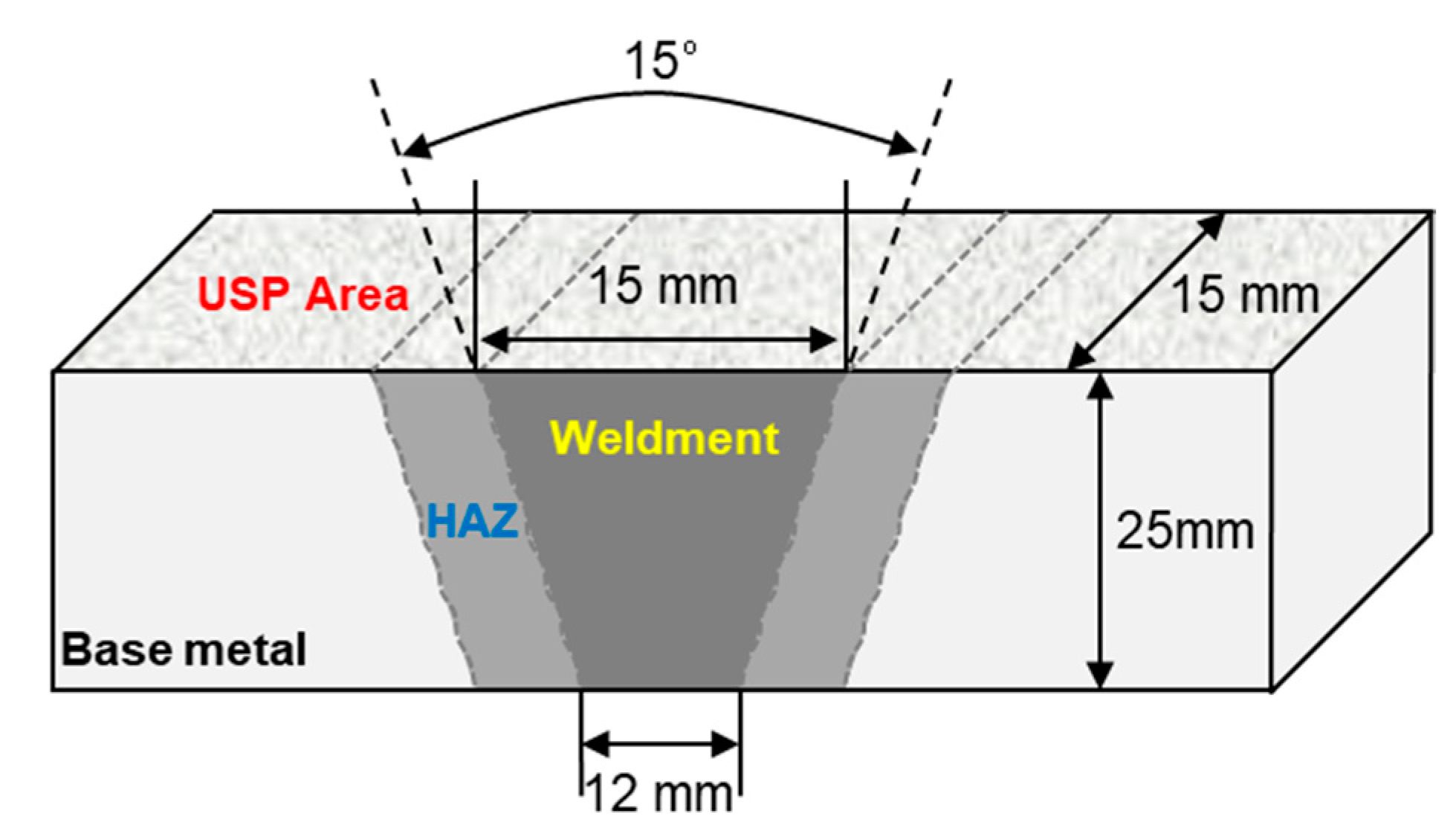


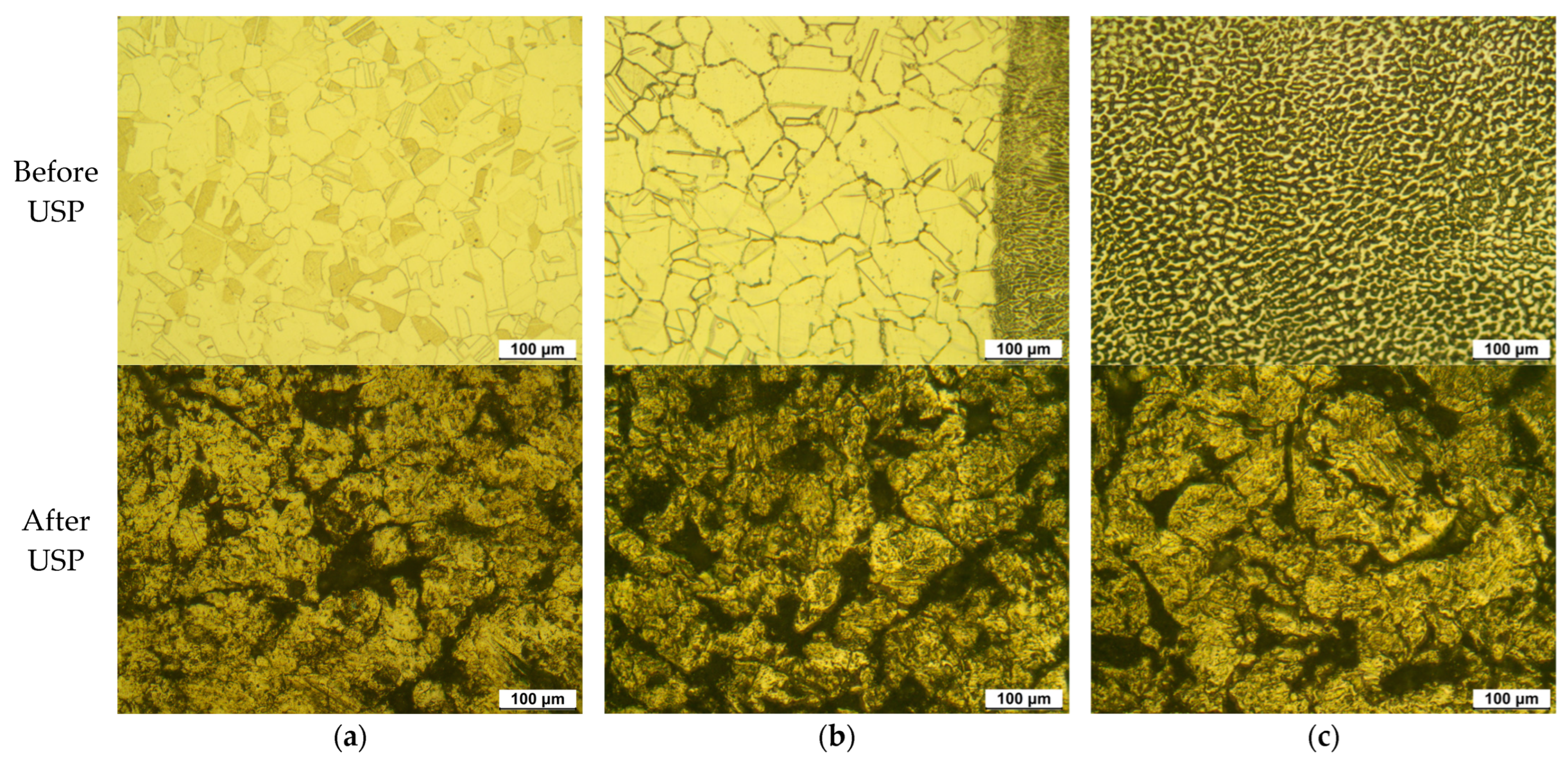
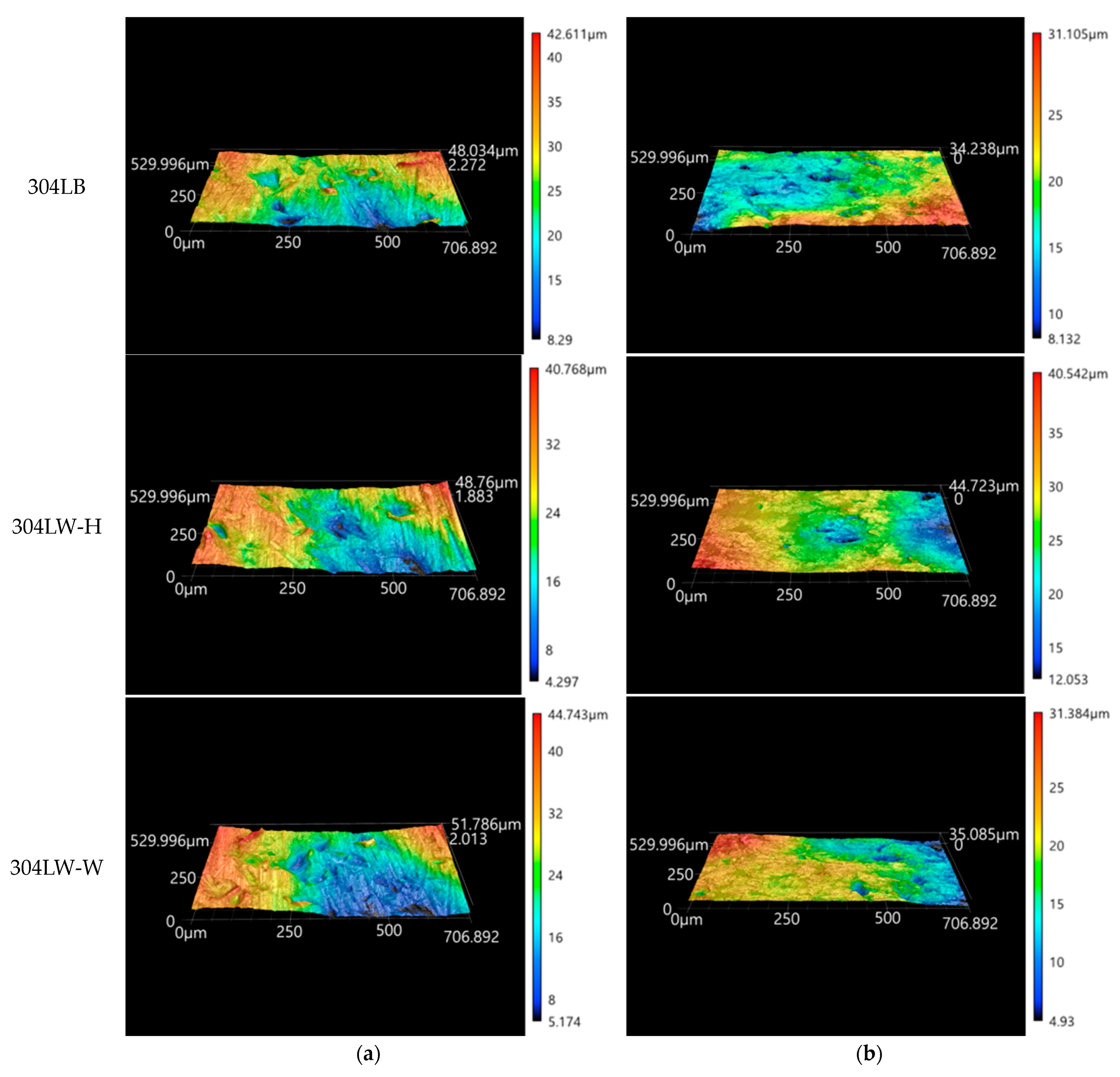





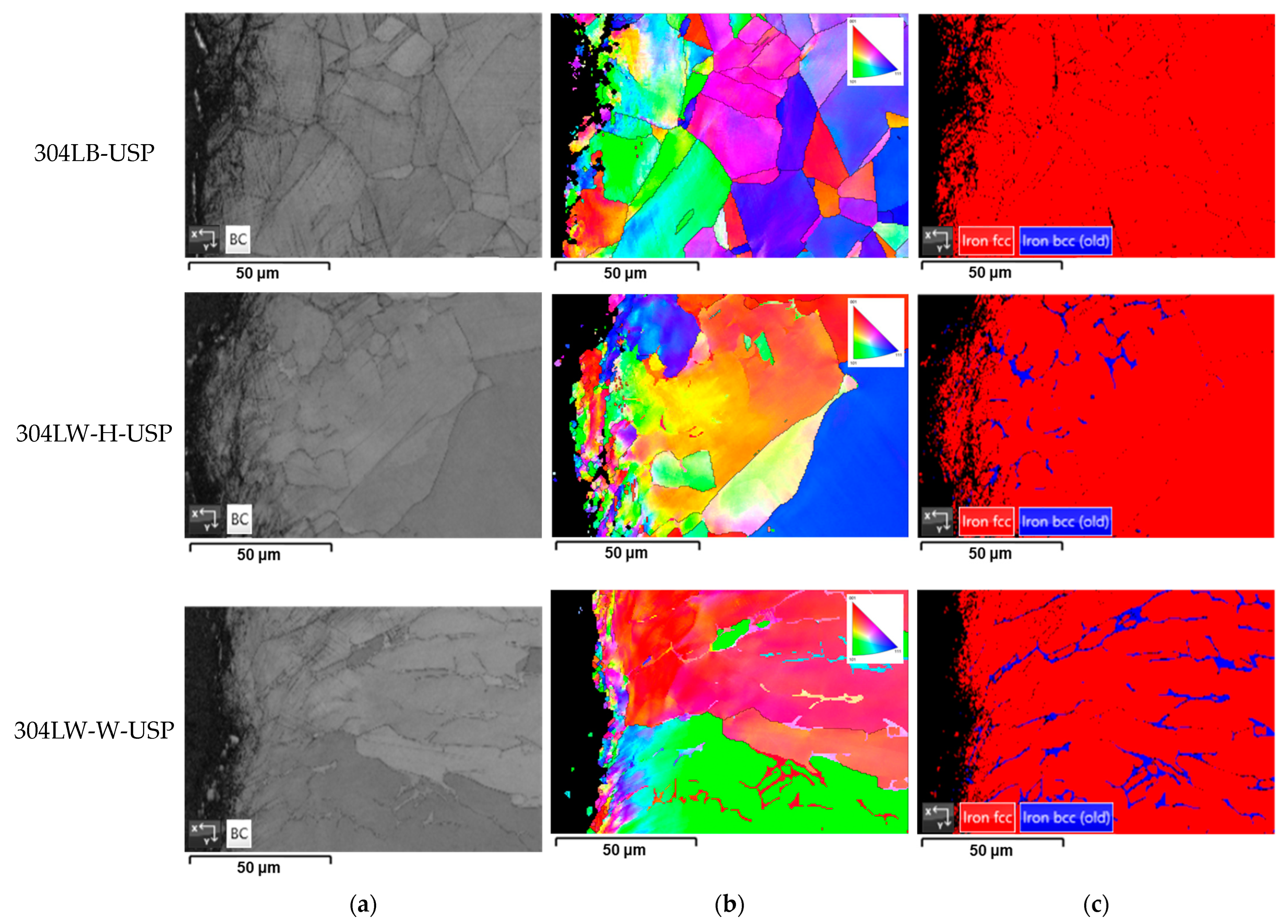


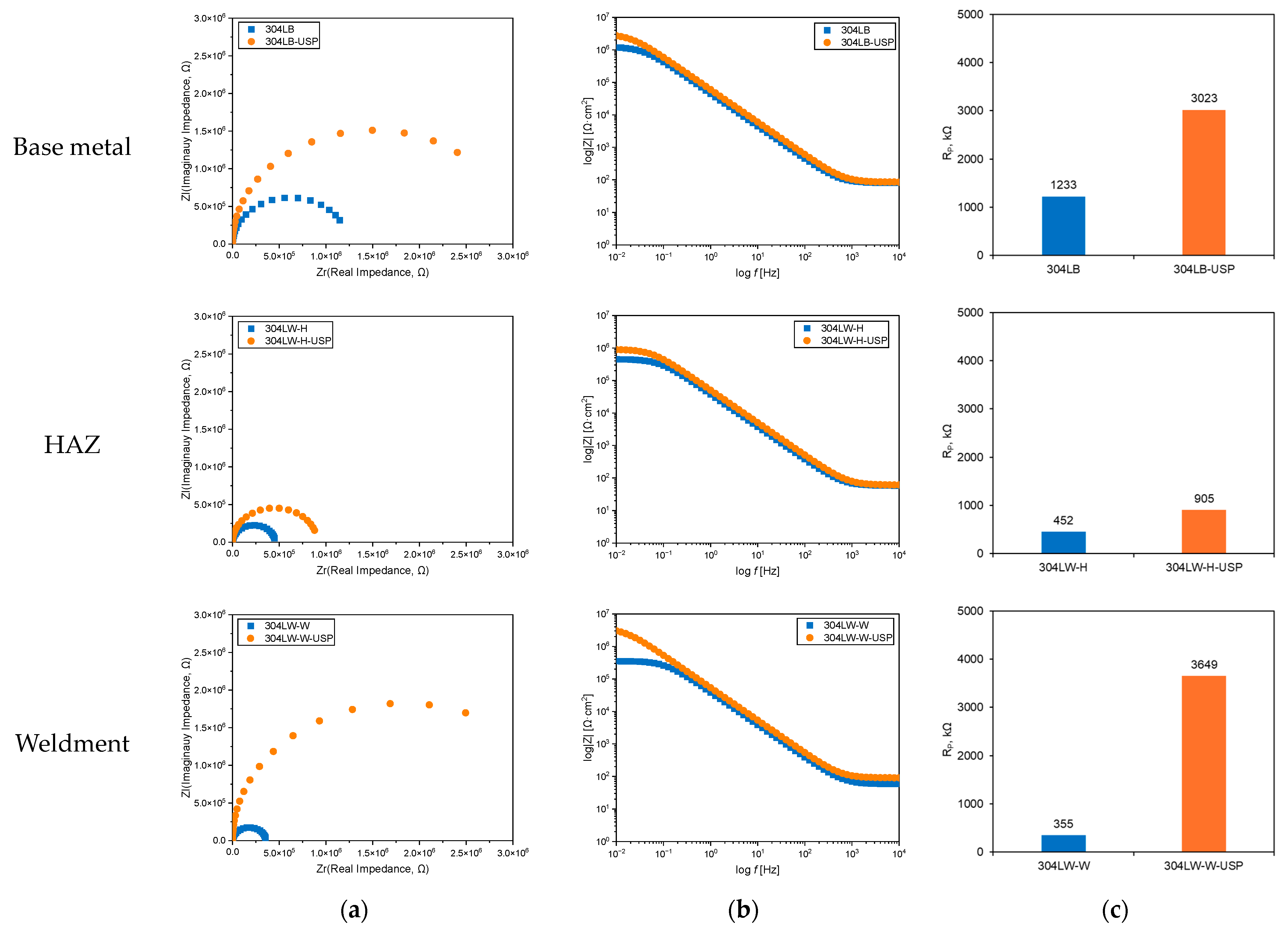
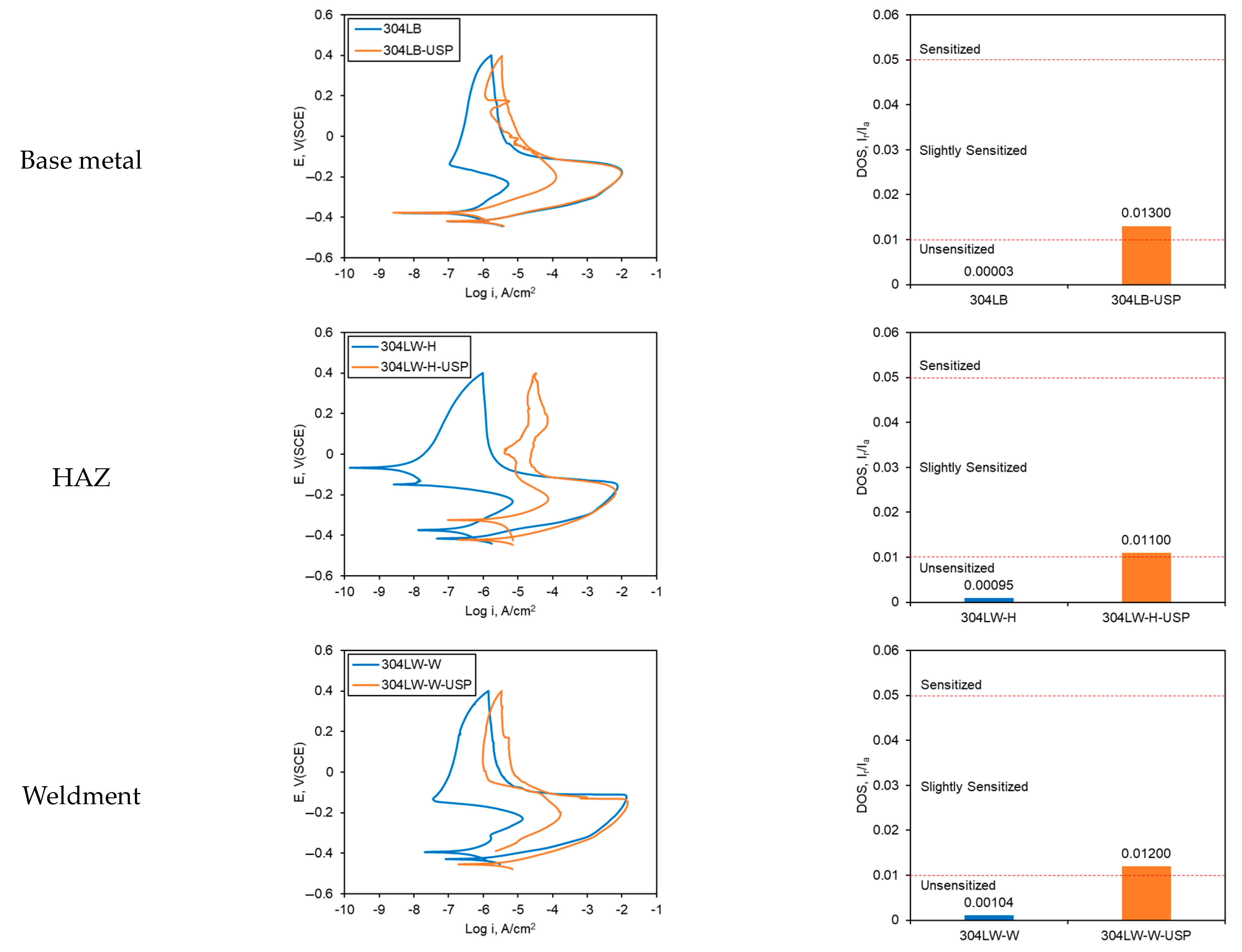

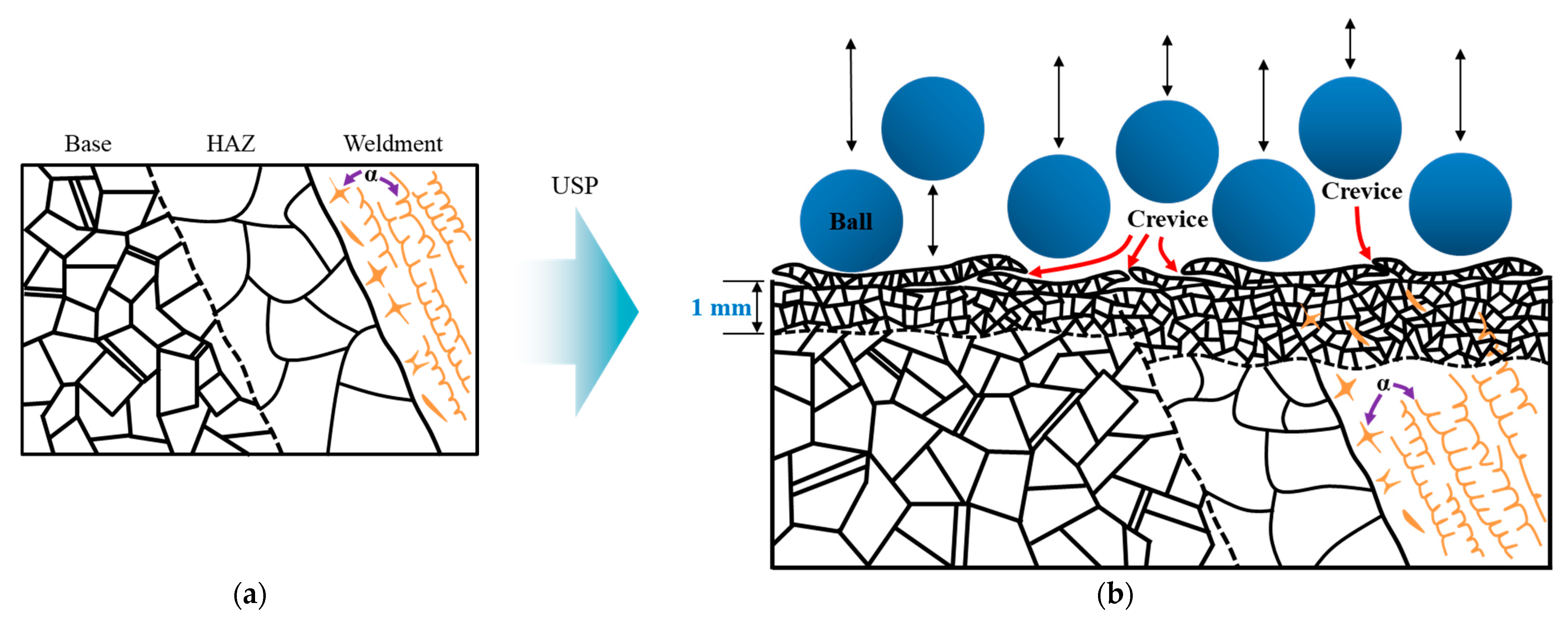
| - | C | Cr | Ni | Mn | Si | Cu | Mo | Co | P | N | S | Cb + Ta | Fe | |
|---|---|---|---|---|---|---|---|---|---|---|---|---|---|---|
| 304L | - | 0.02 | 18.6 | 9.6 | 1.65 | 0.47 | - | - | 0.03 | 0.022 | 0.07 | 0.03 | - | Bal. |
| ER308L | Spec. | ≤0.03 | 19.5–22.0 | 9.0–11.0 | 1.0–2.5 | 0.30–0.65 | ≤0.75 | ≤0.75 | - | ≤0.03 | - | ≤0.03 | - | Bal. |
| analysis | 0.015 | 19.81 | 9.84 | 1.691 | 0.351 | 0.115 | 0.046 | 0.030 | 0.024 | 0.041 | 0.03 | 0.008 | Bal. |
| Welding Process | Current (A) | Voltage (V) | Speed (cm/min) | Shield Gas (%) | Groove Angle (°) | Welding Electrode |
|---|---|---|---|---|---|---|
| GTAW | 245~250 | 14~15 | 9~10 | Ar. 99.9 | 15 | ER308L (Dia. 0.9 mm wire) |
| Alloy | Non-Peened | Ultrasonic Shot Peened | |
|---|---|---|---|
| 304L | Base metal | 304LB | 304LB-USP |
| HAZ area | 304LW-H | 304LW-H-USP | |
| Weldment | 304LW-W | 304LW-W-USP | |
| Specimen Type | Manufacturer | Media | Frequency (kHz) | Bead Material | Medium Diameter (mm) | Bead Weight (g) | Amplitude (µm) | Peening Duration (Min.) | Coverage Rate |
|---|---|---|---|---|---|---|---|---|---|
| Base metal and welded specimen | SONATS Stress Voyager | Air | 20 | 304L | 4 | 25.5 | 70 | 3 | >100% |
| Surface | Base Metal | HAZ | Weldment | |||
|---|---|---|---|---|---|---|
| 304LB | 304LB-USP | 304LW-H | 304LW-H-USP | 304LW-W | 304LW-W-USP | |
| * ER, mV (SCE) | −248 | −285 | −278 | −241 | −20 | −231 |
| ** iR, nA/cm2 | 15.7 | 12.0 | 10.1 | 14.6 | 35.8 | 11.7 |
| *** EP, **** Etr mV (SCE) | 935 | 356 | 1030 | 254 | 789 | −115 |
| Surface | Rs, Ωcm2 | Rp, kΩcm2 | Y, μScm−2sn | n | Error, % | χ2 | |
|---|---|---|---|---|---|---|---|
| Base metal | 304LB | 31.68 | 473.7 | 10.84 | 0.9155 | <10.0 | 0.0180 |
| 304LB-USP | 55.87 | 139.6 | 36.92 | 0.7688 | <10.0 | 0.0525 | |
| Welds | 304LW | 52.66 | 717 | 7.63 | 0.9016 | <10.0 | 0.0098 |
| 304LW-USP | 70.88 | 210.2 | 38.00 | 0.7727 | <10.0 | 0.0496 | |
| Cross-Section | Base Metal | HAZ | Weldment | |||
|---|---|---|---|---|---|---|
| 304LB | 304LB-USP | 304LW-H | 304LW-H-USP | 304LW-W | 304LW-W-USP | |
| * ER, mV (SCE) | −232 | −225 | −367 | −208 | −364 | −209 |
| ** iR, nA/cm2 | 10.8 | 1.8 | 42.8 | 1.9 | 61.7 | 1.5 |
| *** EP, **** Etr mV (SCE) | 310 | 950 | 217 | 46 | 65 | 528 |
| Cross-Section | Rs, Ωcm2 | Rp, kΩcm2 | Y, μScm−2sn | n | Error, % | χ2 | |
|---|---|---|---|---|---|---|---|
| Base metal | 304LB | 80.89 | 1233 | 4.453 | 0.8860 | <10.0 | 0.0117 |
| 304LB-USP | 85.37 | 3023 | 3.192 | 0.9102 | <10.0 | 0.0127 | |
| HAZ | 304LW-H | 58.25 | 452.2 | 5.462 | 0.9131 | <10.0 | 0.0039 |
| 304LW-H-USP | 60.87 | 905.8 | 4.100 | 0.8943 | <10.0 | 0.0098 | |
| Weldment | 304LW-W | 58.75 | 355.1 | 5.397 | 0.9134 | <10.0 | 0.0050 |
| 304LW-W-USP | 90.95 | 3649 | 3.483 | 0.9120 | <10.0 | 0.0062 | |
Disclaimer/Publisher’s Note: The statements, opinions and data contained in all publications are solely those of the individual author(s) and contributor(s) and not of MDPI and/or the editor(s). MDPI and/or the editor(s) disclaim responsibility for any injury to people or property resulting from any ideas, methods, instructions or products referred to in the content. |
© 2024 by the authors. Licensee MDPI, Basel, Switzerland. This article is an open access article distributed under the terms and conditions of the Creative Commons Attribution (CC BY) license (https://creativecommons.org/licenses/by/4.0/).
Share and Cite
Cho, H.; Yoo, Y.-R.; Kim, Y.-S. Effect of Ultrasonic Shot Peening on Microstructure and Corrosion Properties of GTA-Welded 304L Stainless Steel. Crystals 2024, 14, 531. https://doi.org/10.3390/cryst14060531
Cho H, Yoo Y-R, Kim Y-S. Effect of Ultrasonic Shot Peening on Microstructure and Corrosion Properties of GTA-Welded 304L Stainless Steel. Crystals. 2024; 14(6):531. https://doi.org/10.3390/cryst14060531
Chicago/Turabian StyleCho, Hyunhak, Young-Ran Yoo, and Young-Sik Kim. 2024. "Effect of Ultrasonic Shot Peening on Microstructure and Corrosion Properties of GTA-Welded 304L Stainless Steel" Crystals 14, no. 6: 531. https://doi.org/10.3390/cryst14060531





